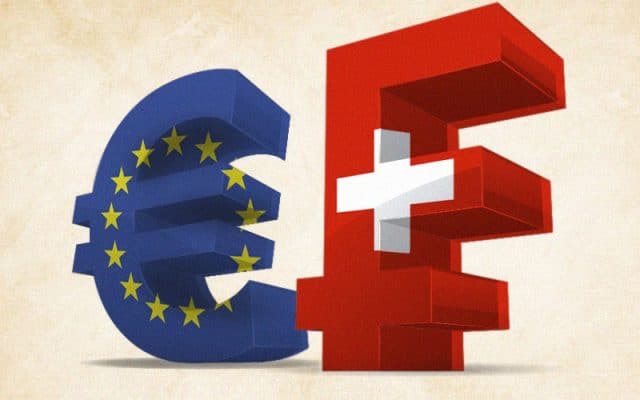Introduction
The EUR/CHF pair, (also known as the “Swissy”), is a major forex pair made up of the Swiss Franc and the Euro. Both currencies have a direct correlation with each other. This is largely due to Switzerland being surrounded by other members of the Eurozone and possessing economic and political ties with all of them. These ties date back to the free trade agreement, established in 1972. More than 100 bilateral agreements followed, allowing Swiss citizens to freely join the European Union workforce as well as open the Swiss labor market to EU citizens. The Swiss thus feels the ripple effect when the Eurozone contracts, because of the relationship between the two economies.
While the economy of Switzerland is heavily reliant on financial industries and experts, the Eurozone is a much more broad-based economy. Switzerland’s economic independence allows it to foster an environment where they can achieve limited yet a realistic growth rate. The stability of the Swiss economy and the Swiss Franc thus ensures the stable economic growth it experiences. This is largely due to limited investments in production and agriculture, as well as exploiting readily available natural resources.
Swiss Economy: a Fortress for International Investors?
There are many reasons why the financial world considers the Swiss Franc (CHF) as a safe haven currency. Traditionally it has retained its value and investors worldwide could park their money in the Franc. Nervous investors during the 2007-2008 financial crisis flocked towards buying the Swiss Franc and its steady performance through the European debt crisis made it more popular.
When the European debt crisis was ensuing in 2011, international investors and the EU bought up Swiss Francs for safety, resulting in an increase in its value. This eventually started negatively affecting the country’s exports. In an attempt to prevent the Swiss Franc from getting too strong, Swiss policymakers made a decision to artificially cap the currency at 1.20 against the Euro. As a result, the Swiss Bank printed more Francs and bought euros with it to maintain this cap.
In 2015 The Swiss National Bank made the unprecedented move of removing the artificial cap from its currency. The sudden increase in value experienced by the Swiss Franc shook the forex market. In spite of this, however, investors still consider the Swiss Franc a safe haven, powered by a strong competitive economy and a robust financial system.
What moves CHF/EUR?
There are two currency pairs that primarily drive the EUR/CHF pair- The USD/CHF and EUR/USD pairs. A 95% correlation is close to perfect for 2 separate, distinct financial instruments. Most currencies on the other hand have a correlation above 50% against the U.S. Dollar.
The common dollar factor in both the EUR/USD and USD/CHF is not the only factor that plays a role in building a strong relationship between the two. The relationship is far stronger when compared with other currency pairs, because of Switzerland’s and the Eurozone’s close ties.
Market Fears
The Swiss Franc, throughout its history, has been a safe-haven currency. There was virtually no inflation in the currency because of a minimum of 40% backing by gold reserves, as well as legal requirements. However, events such as the U.S subprime lending crash and the debt crisis of Greece led the value of the currency to increase,
Both the Eurozone and the Swiss economy are interlinked. This means that problems the Eurozone face will have ripple effects on the Swiss Franc.
Some of the factors that drive the Swiss Franc include:
- Swiss banking services: There is a worldwide demand for Switzerland’s banking services, which acts as a secure and confidential place to hold offshore funds.
- Stable alternative: The Swiss Franc is a stable alternative to the Pound Sterling and United States Dollar when the economy experiences turbulence and uncertainty.
- Economic Data releases: Economic information including GDP data, industrial production figures, inflation rates, etc are all factors that affect the Swiss Franc and the EUR/CHF currency pair.
SNB Policy Rate
Monetary policy and QE programs can be key market movers for the Swissy. As an example in 2015, the Swiss National Bank in an unexpected move, removing the fixed 1.20 francs/ euro peg. As a result of the news, the Swiss Franc rallied 30% against the Euro and 25% against the USD. This move, which caused a major upheaval in the markets, was the cause for many foreign exchange brokers going out of business.
Since 2011, there have been several factors that the SNB has considered when changing its policy. Both the Euro and the Swiss Franc started to weaken substantially in 2015, because of the economic strength in the United States, as well as the expected move by the Federal Reserve to hike interest rates. Another important factor was the expectations of quantitative easing from the ECB (European Central Bank)
The market expected the value of the Euro to weaken because of ECB’s Quantitative easing program. This may have required the SNB to print more Swiss Francs to maintain the previous cap. The SNB thus created Francs, using them to buy Euros to prevent the EUR/CHF from falling below 1.20. The Swiss populace got concerned about hyperinflation, forcing the Swiss National Bank to finally remove the peg in 2015.
Short ties with Eurozone
Switzerland has always been a neutral nation, which is a leading factor in the country’s economy and currency’s success. Even though it’s independent of the Eurozone countries, it does line up several of its policies with fellow EU countries. The fact that it is a destination country for the storage of offshore funds also means that Switzerland has less sensitivity to the economic performance of its neighbours.
Data from the Bank of International Settlements indicate that the Swiss Franc contributes about 5% to the total global foreign exchange transactions. The USD/CHF pair is the sixth most traded currency pair. Investors looking to place funds into the Swiss Franc should keep its low month to month volatility as well as its gradual volatility.
The Conclusion
Despite the fact that Switzerland’s nominal GDP is only 19th in the world, the Swiss Franc is the sixth most traded currency. Even though the country has a reputation for financial conservatism and prudence, countries do not commonly hold the Swiss Franc as a reserve currency. The Swiss National Bank targets a consistent inflation rate of 2%. It generally refrains from engaging in any monetary policies that are simulative, due to any economic downturn. The EUR/CHF pair is the third most frequent in cross-currency trades in the forex market.




